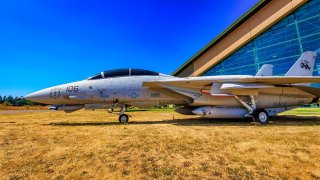F-14 Tomcat Landed on An Aircraft Carrier After Its 'Nose' Fell Off
In 1991, an F-14 Tomcat from the U.S. Navy's Ghost Riders squadron experienced a critical in-flight malfunction when its nose cone detached due to a landing mechanism failure over the Persian Gulf.
Summary and Key Points: In 1991, an F-14 Tomcat from the U.S. Navy's Ghost Riders squadron experienced a critical in-flight malfunction when its nose cone detached due to a landing mechanism failure over the Persian Gulf.
-Pilot Lt. Cmdr. Joe F. Edwards recounted the incident, explaining that corrosion had caused the radome's locking mechanism to fail. The aircraft's wings became immobilized, and essential flight controls like flaps and wing spoilers were inoperative, making landing extremely challenging.
-Despite the odds, Edwards skillfully managed to land the Tomcat by dumping fuel to lighten the aircraft and catching the arresting cable at maximum allowable speed, averting disaster.
F-14 Tomcat's Incredible Emergency Landing: When the Nose Cone Came Off
Back in the late 1940s, the U.S. Navy Fighter Squadron 193 (VF-193) was established.
Throughout the next decade, the squadron would make two deployments to the Korean War before being redesignated VF-142 in the early 1960s.
During this time period, the Ghost Riders flew the F-4 Phantom II for more than 11 years, including a few combat tours in the Vietnam War.
Finally, by 1974 the squadron began flying the fighter that would become synonymous with the Ghost Riders until their dissolution in the mid-1990s- the F-14 Tomcat.
Introducing the F-14 Tomcat
The F-14 platform has become widely popularized by the box office hits Top Gun and Top Gun: Maverick. While the characters Goose and Maverick have become household names, many are not aware of the true prowess of the formidable platform.
In fact, the Tomcat could fly at nearly unprecedented speeds of Mach 2.3, making it just as speedy as the fifth-generation F-22 Raptor. Throughout its years of service in the U.S. military, the Tomcat deployed to Vietnam, Libya, Iraq’s Gulf War, and Operation Iraqi Freedom. The Tomcat was retired in 2006, however, the platform lives on in history as a legendary airframe.
The Infamous Mishap:
While the fighter was leaps and bounds ahead of competitor fighters in its hay day, the Tomcat was still susceptible to mishaps. In 1991, the crew from the Ghost Riders squadron had to make an emergency landing when the nose cone came off of the F-14 they were flying due to a landing mechanism failure. The incident occurred at a height of over 8,000m over the Persian Gulf off the USS Dwight D. Eisenhower (CVN-69).
Pilot LtCdr. Joe F. Edwards described the mishap to the Aviation Geek Club: “Yeah, there was a locking mechanism at the 6 o’clock position underneath the fuselage on the F-14 where you lock the radome down … radome is radar dome … there’s a flat radar antenna back behind there, and the locking mechanism had corroded and actually fell out into the ocean.” The pilot continued that after recognizing that the airframe’s wings were immobilized, he knew they were in for one wild landing. Additionally, the Tomcat had no flaps and would not be able to use wing spoilers to reduce speed once it hit the runway.
According to the pilot, “We dumped fuel to lighten the weight to get the approach airspeed as low as possible, but I saved enough gas to make it to Carswell if my plan didn’t work and I had to wave off,” adding that “As we started our approach, the Commanding Officer radioed me that the emergency vehicles were in position and that LSOs (Landing Signal Officers) were on station and ready for recovery.
“Luckily, all those approaches I practiced in the trainer helped me land the Tomcat exactly where I wanted and sure enough, it worked. My hook snagged the arrestment cable right at the maximum allowable speed and it operated as advertised even though I pulled every inch of available cable down the runway.”
About the Author
Maya Carlin is an analyst with the Center for Security Policy and a former Anna Sobol Levy Fellow at IDC Herzliya in Israel. She has by-lines in many publications, including The National Interest, Jerusalem Post, and Times of Israel. You can follow her on Twitter: @MayaCarlin.
All images are Shutterstock.


